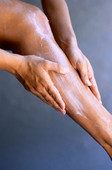
FRIDAY, Feb. 18 (HealthDay News) — A disease the affects your legs could warn you about potential heart trouble, new research suggests.
About 9 million Americans over the age of 50 have peripheral arterial disease (PAD), which puts them at increased risk for heart attack, according to the Vascular Disease Foundation and its PAD Coalition. But many people don’t know they have the condition, the foundation says.
PAD occurs when arteries in the legs become narrowed or clogged with fatty deposits. The reduced blood flow to the legs can cause muscle pain when walking, disability, amputation and poor quality of life. And if you have blocked arteries in your legs, you’re likely to have blocked arteries elsewhere in your body, including your heart.
Symptoms of PAD include: fatigue, heaviness, tiredness or cramping in the calf, thigh or buttock muscles that occurs during activity but goes away with rest; foot or toe pain at rest that often disturbs sleep; skin wounds or ulcers on the feet or toes that are slow to heal.
“Often, people think leg discomfort or slow-healing sores are just a part of aging, yet they can be signs of a serious disease,” Dr. Joseph Caporusso, chair of the PAD Coalition, said in a Vascular Disease Foundation news release. The coalition includes more than 80 North American health care organizations, professional societies, government agencies and corporations.
“Through early detection and proper treatment, we can reduce the devastating consequences of PAD and improve the nation’s cardiovascular health,” Caporusso said.
People over 50 are at risk for PAD, and the risk increases if you are a current or former smoker, black, or have diabetes, high blood pressure, high blood cholesterol, or a history of coronary heart disease or stroke.
People who should be tested for PAD include:
- Adults age 70 and older
- Adults with any symptom of PAD
- Adults younger than 50 with diabetes and at least one other risk factor
- Adults 50 and older with diabetes or a history of smoking
To test for PAD, health professionals compare blood pressure in the ankles to blood pressure in the arms.
More information
The U.S. National Heart, Lung, and Blood Institute has more about peripheral arterial disease.

